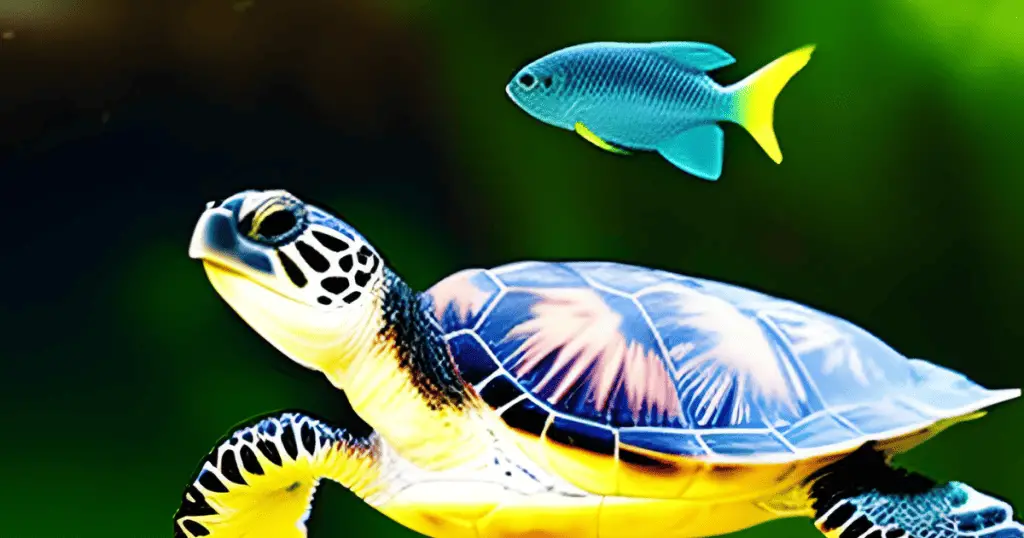Turtles and fish can live together in the same tank if certain considerations are met. It is crucial to choose compatible species that have similar environmental requirements and temperaments. Maintaining a thriving aquatic environment involves ensuring water quality and filtration, providing adequate space and enrichment, implementing individualized feeding strategies, and remaining vigilant and adaptable to changes.
With proper planning, care, and attention to the unique needs of both turtles and fish, it is possible to create a harmonious coexistence where these fascinating creatures can thrive together in the same tank.
The Aquatic Odd Couple
Turtles and fish, although both denizens of the water, possess distinct characteristics and requirements. It’s important to understand these differences before attempting to house them together.
Turtles are reptiles, known for their slow-paced nature and semi-aquatic lifestyle. On the other fin, fish are aquatic creatures with streamlined bodies designed for swift movement.
This stark contrast in behavior and physiology raises a few questions: Can they peacefully coexist? Will the turtles view the fish as potential snacks, or can they peacefully share the same tank?

Compatibility Considerations
- Tank Size and Space Allocation: Turtles are generally larger and require more space compared to most fish species. Ensuring an adequately sized tank is essential to provide each inhabitant with ample room to swim, explore, and establish territories. A crowded tank can lead to stress and aggression among the tank mates.
- Water Parameters: Turtles and fish have varying water parameter preferences. Turtles thrive in freshwater environments, while different fish species may require specific water conditions, such as pH levels and temperature. Striking a balance that meets the needs of both turtles and fish is crucial for their overall health and well-being.
- Dietary Needs: Turtles are omnivorous and have a diverse diet that includes both plant matter and live prey. Some turtles, particularly larger species, may view smaller fish as potential food. It’s important to consider the compatibility of their dietary requirements and potential predation risks.
- Territorial Behavior: Turtles are known to be territorial creatures, especially during breeding seasons. They may display aggression towards tank mates that encroach upon their perceived territory. Understanding the territorial tendencies of both turtles and fish is crucial to avoid conflicts within the tank.
A Delicate Balance
Creating a harmonious aquatic environment for turtles and fish requires careful attention to detail and continuous monitoring. Here are some tips to help strike a delicate balance:
- Tank Dividers: If you’re unsure about the compatibility of your turtles and fish, consider using tank dividers. These physical barriers can provide a safe space for each species, allowing you to observe their interactions without the risk of aggression or predation.
- Adequate Hiding Places: Providing ample hiding spots, such as rocks, caves, and aquatic plants, allows both turtles and fish to retreat and establish their own territories within the tank. This helps reduce stress and promotes a sense of security for all inhabitants.
- Species Selection: Carefully research and select fish species that are known to be compatible with turtles. Certain fish species, such as larger, fast-swimming varieties, may be less likely to be viewed as prey by turtles. Seek advice from experienced aquarists or consult with a knowledgeable aquatic specialist to make informed choices.
“Creating a harmonious aquatic environment requires a delicate balance between the needs of turtles and fish.” – Aquatic Specialist
As you embark on the journey of cohabitating turtles and fish, remember that each tank setup is unique. Close observation, regular maintenance, and adjustment of the tank’s parameters will be necessary to ensure the well-being of all inhabitants.
Turtles and Fish: A Match Made in Aquatic Heaven?
While not all turtle and fish species are suitable tank mates, there are some combinations that have proven to be more successful. Here are a few turtle species that have shown compatibility with certain fish species:
- Red-eared Sliders (Trachemys scripta elegans): These popular turtles are known for their vibrant red markings and friendly demeanor. Red-eared sliders can cohabit with certain fish species, such as:
- Rosy Red Minnows (Pimephales promelas): These small, robust fish are often used as turtle tank mates. They are fast swimmers and less likely to be viewed as prey by the turtles.
- White Cloud Mountain Minnows (Tanichthys albonubes): These peaceful and colorful fish are well-suited for community tanks, including those shared with red-eared sliders.
- Musk Turtles (Sternotherus spp.): Musk turtles are smaller in size compared to red-eared sliders, making them more suitable for smaller tank setups. They can coexist with fish species like:
- Guppies (Poecilia reticulata): These small, lively fish with vibrant colors can thrive alongside musk turtles, provided the tank has ample hiding places.
- Platies (Xiphophorus spp.): These peaceful and easy-to-care-for fish can add a splash of color to the tank while cohabitating with musk turtles.
It’s important to note that these are just a few examples, and compatibility can vary based on individual temperaments and tank conditions. Always research specific turtle and fish species to ensure a greater chance of success.
Monitoring and Adaptation
When introducing turtles and fish to a shared tank, close observation is vital. Keep an eye on the interactions between the species and monitor their behavior and well-being. If any signs of stress, aggression, or predation are observed, it may be necessary to make adjustments to the tank setup or reconsider the compatibility of the chosen species.
Remember, every aquatic environment is unique, and what works for one tank may not work for another. Patience, flexibility, and the willingness to adapt are key to maintaining a successful cohabitation.
Promoting Peaceful Coexistence
To foster a harmonious atmosphere within the tank, consider the following tips:
- Adequate Space and Hiding Spots: Ensure the tank is spacious enough to accommodate both the turtles and fish comfortably. Provide ample hiding spots such as rocks, caves, and vegetation to allow each species to establish their territories.
- Proper Feeding Strategies: Ensure that all tank inhabitants are receiving appropriate and well-balanced diets. Feed the turtles and fish separately to minimize competition for food and reduce the risk of predation.
- Regular Maintenance: Perform regular water quality checks, maintain proper filtration systems, and carry out routine tank cleanings. This helps create a healthy environment for both turtles and fish.
By carefully selecting compatible turtle and fish species, closely monitoring their interactions, and providing a suitable environment, you can increase the chances of a successful and harmonious coexistence.
Water Quality and Filtration
High water quality is crucial for the health and well-being of all tank inhabitants. Consider the following tips for maintaining optimal water conditions:
- Filtration System: Invest in a reliable filtration system that can adequately handle the waste produced by both turtles and fish. A combination of mechanical, biological, and chemical filtration methods can help keep the water clean and free from harmful substances.
- Regular Water Changes: Perform regular water changes to remove accumulated toxins and maintain proper water parameters. The frequency and volume of water changes depend on the size of the tank, the number of inhabitants, and the filtration system in place. Aim for a balance between stability and freshness in the tank environment.
- Water Parameters: Ensure that the temperature, pH level, and water hardness are suitable for the specific needs of both the turtles and fish in your tank. Research the preferred parameters for each species and make adjustments as necessary to create a comfortable and healthy environment.
Providing Adequate Space and Enrichment
Creating a spacious and enriched environment is essential for the physical and mental well-being of turtles and fish. Consider the following guidelines:
- Tank Size: Provide a tank that is spacious enough to accommodate the adult size of your turtles and allows ample swimming space for the fish. Overcrowding can lead to stress, territorial conflicts, and compromised water quality. Research the space requirements for your chosen species and provide accordingly.
- Aquatic Plants: Incorporate live aquatic plants into the tank. They serve as natural filtration, oxygenation, and hiding spots for the fish. Additionally, turtles may nibble on certain plants, so choose species that are safe and non-toxic.
- Aquatic Decorations: Introduce a variety of decorations, such as driftwood, rocks, and artificial caves, to create a visually appealing and stimulating environment. These features provide hiding places, resting spots, and opportunities for natural behaviors, enhancing the overall well-being of both turtles and fish.
Individualized Feeding Strategies
Turtles and fish have different dietary requirements, and it’s essential to tailor your feeding strategies accordingly. Consider the following guidelines:
- Species-Specific Diets: Research the specific dietary needs of each species and provide a nutritionally balanced diet. Turtles typically require a combination of commercial turtle pellets, leafy greens, and occasional live or frozen prey items. Fish may have specific preferences for pellets, flakes, or live/frozen foods. Avoid overfeeding, as it can lead to poor water quality and obesity.
- Separate Feeding Areas: To minimize competition and ensure all tank inhabitants receive adequate nutrition, consider separating the feeding areas for turtles and fish. Use feeding platforms or floating feeders for turtles and sinking or floating food for fish. This helps reduce aggression and ensures that each species gets its fair share of food.
Vigilance and Adaptability
Even with proper planning and care, it’s important to remain vigilant and adaptable to changes in the tank dynamics. Keep an eye out for any signs of stress, aggression, or health issues among your turtles and fish. If necessary, be prepared to make adjustments to the tank setup, seek veterinary advice, or consider rehoming certain individuals to maintain a harmonious and thriving environment.
Enjoy the Aquatic Symphony
Creating a successful and harmonious coexistence between turtles and fish in the same tank requires careful consideration, patience, and dedication. By choosing compatible species, providing suitable habitats, and maintaining optimal water conditions, you can enjoy the beauty and wonder of an aquatic symphony in your own home.
Remember, every tank is unique, and it may take time to find the perfect balance for your specific combination of turtles and fish. Observe their interactions, make adjustments as needed, and revel in the joy of witnessing these captivating creatures sharing a harmonious underwater world.




Leave a Reply